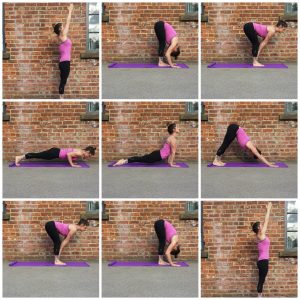Posted on August 08, 2018 by Emily Forbes
The 3 day yoga blog extravaganza continues. First “What is yoga“, followed by “Buddha Balls” and now “how to perform a simple sun salutation”. I mentioned in the “What is yoga” blog that you can learn a sequence so that you can practise yoga where ever you go; sun salutations are just that. There are many different types of sun salutation or “surya namaskara” but today we’ll look at the Ashtanga ‘A’ sequence. A salutation sequence is a set of postures/asanas which flow into one another through connection of breath-vinyasa.
Why do sun salutations?
- Sun salutations help to warm up the body. The Ashtanga sequence is carefully orchestrated to prepare the body for the asanas which will follow in the series. For example upward facing dog is a actually a back bend which will prime you for urdhva dhanurasana (upward bow/wheel pose).
- Sun salutations can be a type of moving meditation. Make sure not to “check out” and bring full awareness to your breath and movement.
- The sequence can be a workout in itself building cardiovascular fitness and helps to lengthen, strengthen, flex and extend the body.
How to perform Surya Namaskara A:
- Samasthiti (mountain pose pose or Tadasana). Stand upright, looking forward hands at the side.
- Urdhva hastasana (raised hands pose). Inhale, sweep hands above head into prayer.
- Uttanasana (standing forward bend). Exhale fold forward.
- Ardha uttanasana (half forward fold). Inhale lift the chest and gaze with a flat back. Plug the hands onto the mat or shins).
- Chaturanga dandasana (4 limbed staff pose/low plank). Traditionally you would exhale and jump back into this pose. Modern sequence will usually follow exhale as you step or jump into plank and lower into chaturanga.
- Urdhva mukha svanasana (upward facing dog). Inhale, lift the chest into up dog making sure you are strong in the legs and shoulders are away from the ears. One modification here is bhujangasana (cobra pose).
- Ardho mukha svanasana (downward facing dog). Exhale, push the body into downdog. Hold here for 5 breaths. In this posture the spine is long, bending the knees if necessary. Draw the shoulder blades down the back away from the ears and drop the heels towards the ground.
- Ardha uttanasana. At the end of your fifth breath step or jump back into your half forward fold on the inhale.
- Uttanasana. Once again exhale to fold forward.
- Urdhva hastasana. Inhale sweep the hands back above the head into prayer.
- Samasthiti. Exhale, release the hands back to your sides ready to start the sequence again.

Further instruction:
In a full Ashtanga series you would perform five surya namaskara A then five B before entering into your series of set poses. In a shortened version you may only perform 3 of each. As stated you could perform this sequence on its own, perhaps starting with 3 and building up to 12. Make sure every move is linked with the breath, initiating a movement on the inhale and ending the pose on the exhale. The speed of the breath can be used to make the practice slow and calming or energising and heating. The spine is the most important body part to protect, bend the knees as much as you need in many of the postures to give it length and prevent rounding in the back. Listen to your body, only do what feels good and modify where you need to.
Enjoy your practice. I’m always happy to chat about yoga if you want to know more. Tag me in your pictures #tobeawarrior @tobeawarrior
Namaste x

